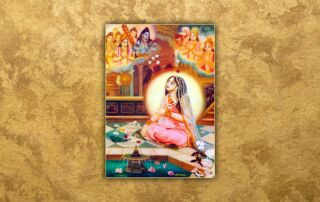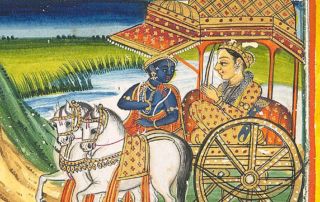Garbha Stotra Verse Five
In 1870, Śrīla Bhaktivinoda Ṭhākura wrote a commentary to the Garbha Stotra of Śrīmad Bhāgavatam (10.2.26-40) wherein the Demigods pray to Kṛṣṇa within the womb of Devakī. His commentary, the Sambandha Tattva Candrikā (‘That Moon which Reveals the Reality of One’s Relationship with the Lord’) was based upon that of the famous Vaiṣṇava commentator, Śrī Śrīdhara Svāmī.
Garbha Stotra Verse Four
In 1870, Śrīla Bhaktivinoda Ṭhākura wrote a commentary to the Garbha Stotra of Śrīmad Bhāgavatam (10.2.26-40) wherein the Demigods pray to Kṛṣṇa within the womb of Devakī. His commentary, the Sambandha Tattva Candrikā (‘That Moon which Reveals the Reality of One’s Relationship with the Lord’) was based upon that of the famous Vaiṣṇava commentator, Śrī Śrīdhara Svāmī.
Garbha Stotra Verse Three
In 1870, Śrīla Bhaktivinoda Ṭhākura wrote a commentary to the Garbha Stotra of Śrīmad Bhāgavatam (10.2.26-40) wherein the Demigods pray to Kṛṣṇa within the womb of Devakī. His commentary, the Sambandha Tattva Candrikā (‘That Moon which Reveals the Reality of One’s Relationship with the Lord’) was based upon that of the famous Vaiṣṇava commentator, Śrī Śrīdhara Svāmī.
Garbha Stotra Verse Two
In 1870, Śrīla Bhaktivinoda Ṭhākura wrote a commentary to the Garbha Stotra of Śrīmad Bhāgavatam (10.2.26-40) wherein the Demigods pray to Kṛṣṇa within the womb of Devakī. His commentary, the Sambandha Tattva Candrikā (‘That Moon which Reveals the Reality of One’s Relationship with the Lord’) was based upon that of the famous Vaiṣṇava commentator, Śrī Śrīdhara Svāmī.
Bhagavad-gita – Chapter Eighteen
Śrīla Bhaktivinoda Ṭhākura’s first Bengali commentary to the Bhagavad-gītā named ‘Rasika-Rañjana’ (‘That which delights the relishers of rasa’) was written in 1886 and was a combined translation/commentary. This commentary was based upon Śrīla Viśvanātha Cakravartī Ṭhākura’s Sārārtha-varṣiṇī commentary. The Ṭhākura also gave an elaborate introduction to this work describing the connection between the paths of karma, jñāna and bhakti.
Garbha Stotra Verse One
In 1870, Śrīla Bhaktivinoda Ṭhākura wrote a commentary to the Garbha Stotra of Śrīmad Bhāgavatam (10.2.26-40) wherein the Demigods pray to Kṛṣṇa within the womb of Devakī. His commentary, the Sambandha Tattva Candrikā (‘That Moon which Reveals the Reality of One’s Relationship with the Lord’) was based upon that of the famous Vaiṣṇava commentator, Śrī Śrīdhara Svāmī.
Introduction to Garbha Stotra
In 1870, Śrīla Bhaktivinoda Ṭhākura wrote a commentary to the Garbha Stotra of Śrīmad Bhāgavatam (10.2.26-40) wherein the Demigods pray to Kṛṣṇa within the womb of Devakī. His commentary, the Sambandha Tattva Candrikā (‘That Moon which Reveals the Reality of One’s Relationship with the Lord’) was based upon that of the famous Vaiṣṇava commentator, Śrī Śrīdhara Svāmī.
Bhagavad-gita – Chapter Seventeen
Śrīla Bhaktivinoda Ṭhākura’s first Bengali commentary to the Bhagavad-gītā named ‘Rasika-Rañjana’ (‘That which delights the relishers of rasa’) was written in 1886 and was a combined translation/commentary. This commentary was based upon Śrīla Viśvanātha Cakravartī Ṭhākura’s Sārārtha-varṣiṇī commentary. The Ṭhākura also gave an elaborate introduction to this work describing the connection between the paths of karma, jñāna and bhakti.
Bhagavad-gita – Chapter Sixteen
Śrīla Bhaktivinoda Ṭhākura’s first Bengali commentary to the Bhagavad-gītā named ‘Rasika-Rañjana’ (‘That which delights the relishers of rasa’) was written in 1886 and was a combined translation/commentary. This commentary was based upon Śrīla Viśvanātha Cakravartī Ṭhākura’s Sārārtha-varṣiṇī commentary. The Ṭhākura also gave an elaborate introduction to this work describing the connection between the paths of karma, jñāna and bhakti.
Bhagavad-gita – Chapter Fifteen
Śrīla Bhaktivinoda Ṭhākura’s first Bengali commentary to the Bhagavad-gītā named ‘Rasika-Rañjana’ (‘That which delights the relishers of rasa’) was written in 1886 and was a combined translation/commentary. This commentary was based upon Śrīla Viśvanātha Cakravartī Ṭhākura’s Sārārtha-varṣiṇī commentary. The Ṭhākura also gave an elaborate introduction to this work describing the connection between the paths of karma, jñāna and bhakti.










